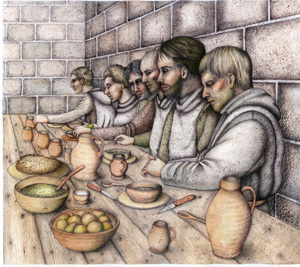|
|
You are here:

 (1/2) (1/2) |
Roche Abbey: the lay-brothers' range
The western range at Roche, as
at other Cistercian houses, was primarily used by lay-brothers who worked and lived at the abbey rather than on the granges. Here
they had their own refectory, dormitory and toilet-block (reredorters).
An infirmary for their use, a three-bayed double-aisled hall, was
situated on the south bank of the river and accessed by a footbridge.
The northern part of the western range was used as a cellar and
also had an outer parlour, which functioned as a meeting place
- merchants might conduct business here, the monks might speak
with family and friends. The parlour also gave access to the cloister.
In Benedictine houses, where there were no lay-brothers, the western
range was occupied by the cellarer and might also accommodate guests.
The western range at Roche was one of the first buildings to
be constructed; it dates from the late twelfth century. The entire
range measured c. 43m x c. 12m externally (c. 41m x c. 9m internally)
and was divided into ten bays. A moderately-sized vaulted cellar
occupied the northernmost three bays. It was here that grain, salted
fish and other provisions for the community were stored, as well
as hides and wool that were to be taken to market or sold to merchants.
The cellar was screened off from the parlour in bay four; a second
partition separated the outer parlour from the lay-brothers’ refectory,
which occupied the remaining six bays. The timber or stone tables
in the refectory were probably arranged around the walls and, like
the monks, the lay-brothers would have faced inwards to eat. As
there was no reading during the lay-brothers’ meals their
refectory had no pulpit. Nonetheless, the lay-brothers were to
remain silent while eating and observe good table manners. The
lay-brothers’ ate the same food as the monks but generally
received larger portions, on account of their heavy labour. They
were also served a light breakfast, the mixt, which was taken by
novices, servers and the infirm. Their food was prepared in the
same kitchen as the monks’ and was passed to the refectory
through a serving hatch in the east wall. The lay-brothers at Roche
may also have gathered in the refectory for their weekly chapter
meeting.
<back><next>
|







 (1/2)
(1/2)